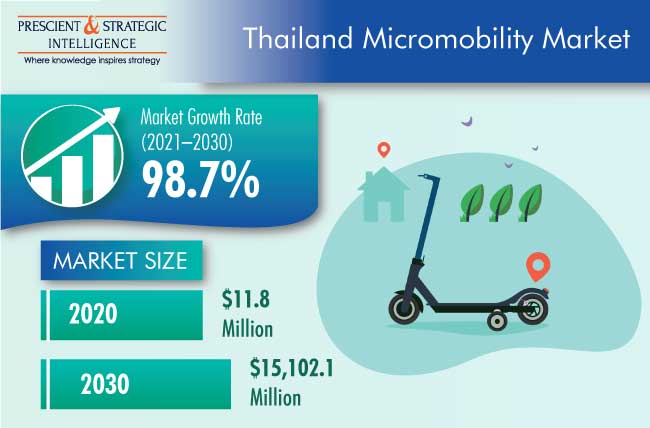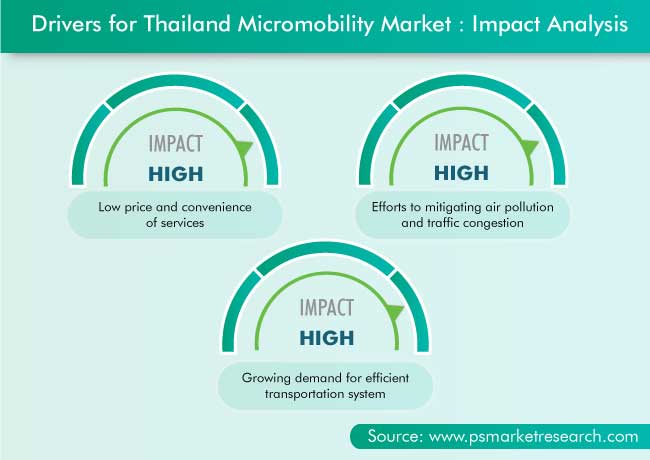Report Code: 12240 | Available Format: PDF | Pages: 98
Thailand Micromobility Market Research Report: By Type (E-Scooters, E-Bikes, E-Mopeds, E-Pods, Bikes, Scooters), Model (First- and Last-Mile, Multimodal), Sharing System (Docked, Dockless) - Industry Analysis and Growth Forecast to 2030
- Report Code: 12240
- Available Format: PDF
- Pages: 98
- Report Description
- Table of Contents
- Market Segmentation
- Request Free Sample
Market Overview
The Thai micromobility market generated $11.8 million revenue in 2020, and it is expected to grow at a CAGR of 98.7% during the forecast period (2021–2030). The key factors responsible for the growth of the market include the low price and convenience of these services and their role in the mitigation of air pollution and traffic congestion and the rising demand for an efficient transport system.
Thailand has been strongly impacted by the COVID-19 pandemic; however, the timely and stringent containment measures launched by the government successfully flattened the infection curve in 2020. Effective containment, limited public gatherings, restricted use of public transportation, and a multipronged economic package limited the impact. Moreover, COVID-19 created ample opportunities for micromobility service providers, as people are becoming inclined toward a transport solution that can ensure social distancing, to reduce the spread of the disease. Micromobility fleets, including e-scooters and e-mopeds, serve as an alternative to public transportation modes, such as buses, trains, and trams. Thus, the demand for micromobility services in the kingdom has risen during these times.

E-Mopeds Held Largest Share due to Their Cost-Effectiveness
E-mopeds dominated the market during the historical period (2019–2020), and they are expected to retain their dominance during the forecast period, based on vehicle type. This can be ascribed to the growing young population of the country, thus resulting in the expanding user base for micromobility services since they are mass users of the internet and updated technologies. Moreover, young students and working professionals are more inclined toward modern means of urban mobility, and, therefore, the demand for cost-effective solutions to meet their daily commuting needs is mostly met by these services.
First- and Last-Mile Model To Witness Faster Growth due to Increasing Disposable Income
The first- and last-mile category is expected to witness the faster growth in the micromobility market of Thailand during the forecast period, based on model. This will mainly be on account of the rising consumer demand for shared mobility services, increasing disposable income, and government concerns over environmental pollution in the country. In an effort toward curbing the pollution levels and reducing the rate of personal vehicle ownership, the government is establishing a strong infrastructure and road network and deploying more electric vehicles for first- and last-mile connectivity.
Investments in Micromobility Market Key Market Trend
Several companies in the Thai micromobility market are focusing on securing funding from major venture capitalists, investors, and automotive original equipment manufacturers (OEMs). This has led to an increase in the competition between the companies and introduction of new products and services to meet the last-mile connectivity requirements of consumers. Some of the leading startups that have raised heavy funding are Ofo Inc., Neuron Mobility Pte. Ltd., and Grab Holdings Inc. Likewise, some of the leading venture capitalists that have invested in micromobility startups are Alibaba Group, Softbank Group Corp., and GSR Ventures.

Low Price and Convenience of Services Key Drivers for Market
Micromobility services in Thailand have seen an increase in popularity in recent years owing to several factors, such as the low weight, compact size, high availability, environment friendliness, and ease of use of the vehicles. When compared to the early stages of the ride-hailing market, the adoption rate of micromobility services has been ten times higher in the kingdom. Micromobility services provide a low-cost travel option, which leads to a large customer base. For instance, Anywheel Pte. Ltd. charges a base fare of $0.30 (THB 10.0) for its bike services, while Ofo Inc. charges bike sharing users a deposit of $3.0 (THB 99.0) and, then, $2.0 (THB 5.0) per 30 minutes.
Growing Demand for Efficient Transportation Systems also Helping Market Advance
“First- and last-mile” is the distance that commuters have to cover between a transportation hub and their journey’s point of origin or destination. As public or shared transport does not connect directly to a person's doorstep, the first- and last-mile distances have traditionally been covered by people driving their cars or walking to their destination, both of which take a significant amount of time and effort. This increases the demand for a reliable last-mile connectivity system, thereby driving the Thai micromobility market.
| Report Attribute | Details |
Historical Years |
2019-2020 |
Forecast Years |
2021-2030 |
Base Year (2020) Market Size |
$11.8 Million |
Market Size Forecast in 2030 |
$15,102.1 Million |
Forecast Period CAGR |
98.7% |
Report Coverage |
Market Trends, Drivers, and Restraints; Revenue Estimation and Forecast, Segmentation Analysis, Impact of COVID-19, Companies’ Strategic Developments, Company Profiling |
Market Size by Segments |
By Vehicle Type; By Model; By Sharing System |
Secondary Sources and References (Partial List) |
Alternative Fuels Data Center (AFDC), Electric Drive Transportation Association (EDTA), Electric Vehicle Association of Asia Pacific (EVAAP), International Energy Agency (IEA), International Kicksled and Scooter Association (IKSA), International Scooter Association (ISA), Light Electric Vehicle Association (LEVA), Mobility as a Service Alliance (MaaS Alliance), National Association of City Transportation Officials (NACTO), Nordic Micromobility Association |
Explore more about this report - Request free sample
Market Players Involved in Service Expansion to Gain Significant Position
The micromobility market of Thailand is fragmented in nature with the presence of several key players. Some of the major players in the industry are Anywheel Pte. Ltd., Neuron Mobility Pte. Ltd., Grab Holdings Inc., Mobike, Ofo Inc., Go Scoot Bangkok, Innotra Co. Ltd., Haupcar Company Limited, Falcon Go, and E-Revolution Co. Ltd.
In recent years, players in the micromobility market of Thailand have been involved in service expansion in order to attain a significant position. For instance:
- In January 2018, Mobike began its operations in Chiang Mai, Thailand, with the support of the city Municipal council, national government agencies, such as the Tourism Authority of Thailand (TAT), as well as local businesses, universities, and other community groups. This service addresses urban transportation needs through the internet of things (IoT) technology and close partnerships with local communities.
Key Players in Thailand Micromobility Market Include:
-
Anywheel Pte. Ltd.
-
Neuron Mobility Pte. Ltd.
-
Grab Holdings Inc.
- Ofo Inc.
-
Go Scoot Bangkok
- Segway Inc.
-
Innotra Co. Ltd.
-
Haupcar Company Limited
-
Falcon Go
-
E-Revolution Co. Ltd.
Market Size Breakdown by Segments
The research offers market size of the Thailand micromobility market for the period 2019–2030.
Based on Type
- E-scooters
- E-bikes
- E-mopeds
- E-pods
- Bikes
- Scooters
Based on Model
- First- and Last-Mile
- Multimodal
Based on Sharing System
- Docked
- Dockless
The micromobility market in Thailand will grow by 98.7% during 2021–2030.
The positive impact of COVID-19 pandemic on the Thai micromobility industry was because these services allow for social distancing, which is not possible with conventional modes of mass transit.
The micromobility market in Thailand has been dominated by e-mopeds.
Key drivers for the Thai micromobility industry are the rising environmental concerns, increasing need for an efficient transport system, and cost-effectiveness and convenience of such services.
The micromobility market of Thailand is fragmented in nature.
Want a report tailored exactly to your business strategy?
Request CustomizationWant an insight-rich discussion with the report author?
Speak to AnalystOur dedication to providing the most-accurate market information has earned us verification by Dun & Bradstreet (D&B). We strive for quality checking of the highest level to enable data-driven decision making for you
Our insights into the minutest levels of the markets, including the latest trends and competitive landscape, give you all the answers you need to take your business to new heights
With 24/7 research support, we ensure that the wheels of your business never stop turning. Don’t let time stand in your way. Get all your queries answered with a simple phone call or email, as and when required
We take a cautious approach to protecting your personal and confidential information. Trust is the strongest bond that connects us and our clients, and trust we build by complying with all international and domestic data protection and privacy laws